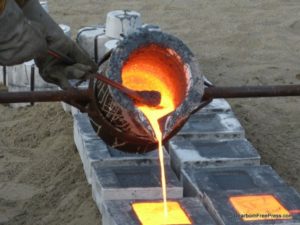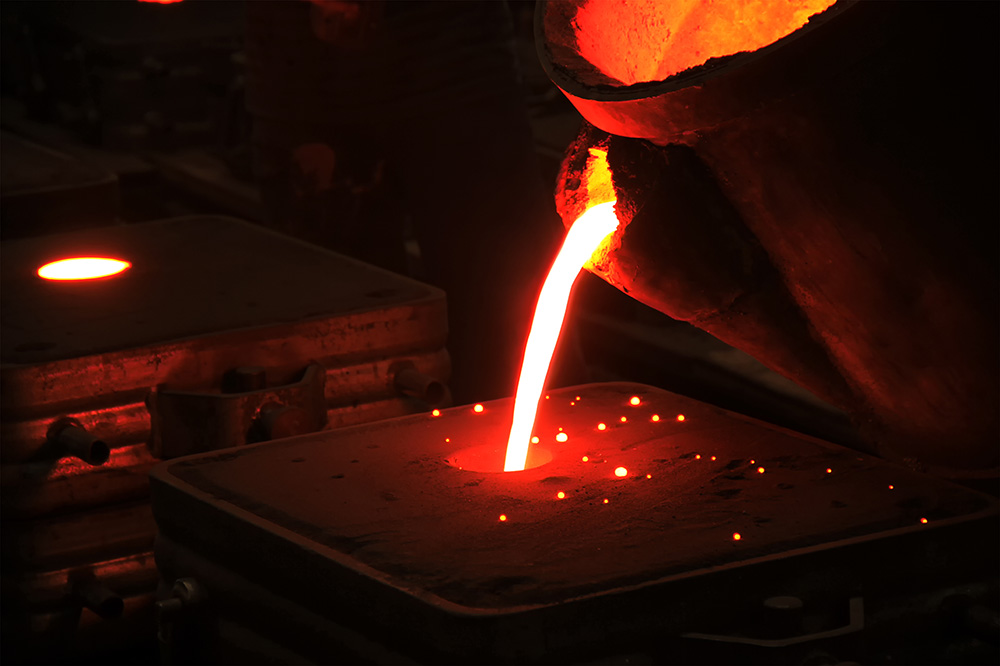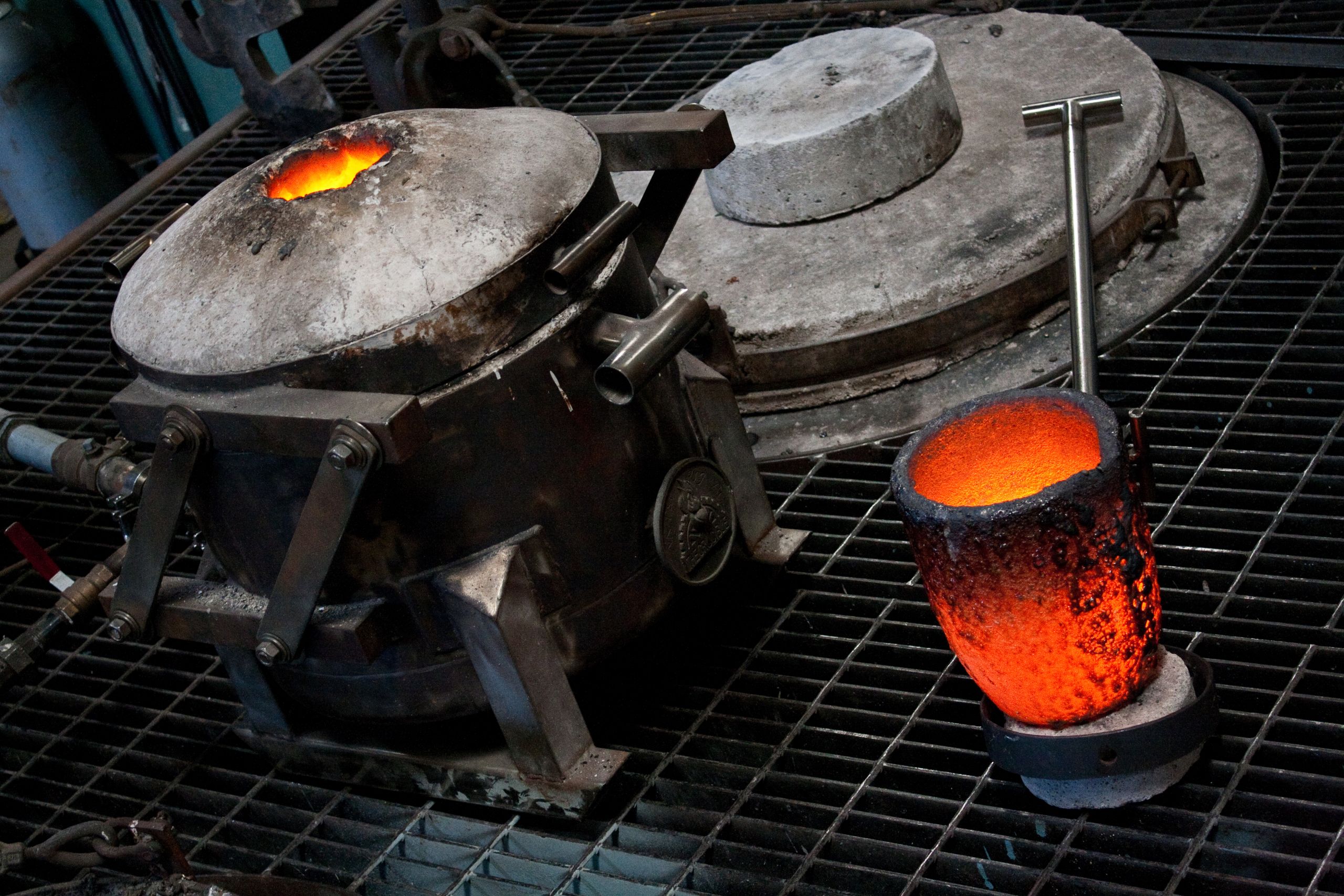How Aluminum Castings support aerospace applications with strength and quality
Wiki Article
Understanding the Metal Castings Process: A Comprehensive Guide for Beginners
The Metal Casting process is a fundamental method in manufacturing that transforms molten steel right into strong types. Newbies must comprehend the different approaches involved, such as sand casting and pass away casting. Comprehending the products, layout principles, and security procedures is just as crucial. Each aspect plays an essential duty in attaining effective end results. As one navigates these intricacies, the question of how to optimize each action for improved results comes to be increasingly important.The Basics of Metal Casting
Although Metal Casting has developed over centuries, its fundamental principles stay constant and indispensable to the manufacturing procedure. At its core, Metal Casting involves the transformation of molten steel into strong things via numerous techniques. The process starts with the production of a mold, which specifies the form of the end product. Once the mold is prepared, steel is heated up to its melting point and put into the tooth cavity. After cooling, the metal solidifies, taking the form of the mold and mildew.There are a number of casting techniques, including sand casting, investment casting, and pass away spreading, each with one-of-a-kind advantages and applications. The option of method relies on factors such as production quantity, material type, and wanted accuracy. Once cast, the last item might undergo additional procedures like machining or surface therapy to achieve the called for coating and specs. Understanding these fundamentals is necessary for any individual curious about the field of Metal Casting.

Recognizing Materials Utilized in Metal Casting
Products play an essential duty in the Metal Casting process, affecting the end product's residential properties and efficiency. Various steels are utilized, consisting of aluminum, steel, iron, and bronze, each offering distinct features fit for particular applications. Aluminum is corrosion-resistant and lightweight, making it ideal for automotive parts. Iron, especially cast iron, is favored for its superb wear resistance and durability. Steel provides high toughness and convenience, frequently made use of in hefty machinery parts. Bronze, known for its corrosion resistance and machinability, is commonly utilized in marine applications.In enhancement to the steels, various casting products, such as sand, plaster, and ceramic, are utilized to create molds. Sand spreading, one of the most prevalent method, makes use of silica sand because of its thermal security and capability to develop complex shapes. Plaster and ceramic molds provide better details but might need even more complicated processes. The option of products directly influences the effectiveness, price, and quality of the spreading procedure.
The Style Process: From Idea to Plan
The design process in Metal Casting begins with the initial principle advancement, where concepts are created and assessed. This is adhered to by the application of CAD modeling methods, permitting specific visualizations of the design. The blueprint finalization steps guarantee that all requirements are accurately recorded for production.First Concept Development
Preliminary idea advancement marks an important phase in the Metal Casting process, where ideas transform into substantial designs. Throughout this phase, developers team up with designers and stakeholders to brainstorm and refine preliminary principles. They take into consideration aspects such as performance, looks, and manufacturability, ensuring that the design satisfies the needed specs and efficiency criteria. Illustrations and harsh drafts are produced to picture the principles, permitting for preliminary assessments of feasibility and cost-effectiveness. This stage also entails recognizing products and prospective casting methods that align with the layout goals. Inevitably, first principle growth prepares for a comprehensive blueprint, guiding the subsequent phases of the spreading process and making certain a successful change from concept to fact.CAD Modeling Techniques
Transforming ideas into precise layouts, CAD modeling strategies play a crucial function in the Metal Casting process. These methods use innovative software program to create comprehensive three-dimensional models that properly show the designated product. By employing tools such as parametric modeling, solid modeling, and surface area modeling, developers can manipulate dimensions and shapes with ease. CAD systems also promote simulation and analysis, permitting the recognition of possible defects prior to manufacturing starts. This proactive technique lowers material waste and maximizes the style for manufacturability. In addition, CAD models can be quickly customized, making it possible for quick iterations based upon responses. Fundamentally, CAD modeling works as the foundation of the layout procedure, linking the void in between preliminary concepts and the eventual production-ready layouts.Blueprint Completion Tips
Adhering to the development of comprehensive CAD models, the following stage includes plan finalization, which is crucial in translating digital layouts into actionable prepare for production. This procedure starts with evaluating the CAD models for precision and compliance with specifications. When validated, the measurements, tolerances, and product requirements are carefully described to ensure clarity. Incorporating notes and annotations aids connect essential info concerning casting processes, surface finishes, and setting up demands. The settled blueprint goes through a rigorous authorization procedure, typically involving collaboration with designers and manufacturing groups to deal with any prospective concerns. Alterations are made and approvals gotten, the blueprint is officially released, serving as the fundamental document for the succeeding stages of Metal Casting, consisting of pattern making and mold design.The Metal Casting Methods Discussed

Metal Casting strategies incorporate a selection of methods used to form molten metal into wanted forms. These methods differ according to the sort of product, complexity of the layout, and production volume. Sand casting is just one of the most typical methods, involving the production of a mold and mildew from sand to hold the liquified steel. Investment casting, or lost-wax spreading, permits elaborate designs by utilizing a wax pattern that is disappeared. Pass away casting utilizes high-pressure injection of molten steel into a mold, ideal for automation. Various other techniques consist of irreversible mold casting, which utilizes helpful site recyclable mold and mildews, and centrifugal spreading, where rotational forces assist in loading the mold. Each method has its benefits and applications, making it vital for producers to choose the ideal approach based on their specific needs and demands. Comprehending these techniques is crucial for any person associated with the Metal Casting process.
Finishing Processes: Enhancing Your Casted Item

Completing processes play an important role in improving the high quality and appearance of casted products. Numerous surface area treatment methods, such as sprucing up and covering, are utilized to boost toughness and looks. Furthermore, high quality evaluation methods guarantee that the end product meets defined standards and efficiency needs.
Surface Area Therapy Techniques
A variety of surface area treatment methods play a crucial function in boosting the quality and long life of casted products. These strategies include approaches such as shot blasting, brightening, and covering. Shot blowing up efficiently eliminates surface area imperfections, enhancing the visual and have a peek at this site useful features of the spreading. Sprucing up gives a smooth coating, which is specifically crucial for decorative applications and components needing very little friction. Coating methods, such as electroplating or powder layer, deal additional protection versus rust and wear, ensuring resilience. Surface therapies can boost bond for subsequent procedures, such as painting or bonding. By employing these techniques, suppliers can achieve exceptional surface top quality, which is important for the performance and life expectancy of Metal Casting in numerous applications.High Quality Inspection Methods
Reliable top quality examination methods are vital for guaranteeing the stability and efficiency of casted items after the completing processes. Different methods are used to evaluate the top quality of Metal Casting, consisting of aesthetic examination, dimensional checks, and non-destructive screening (NDT) Aesthetic inspection enables the recognition of surface area defects, while dimensional checks guarantee that products meet defined resistances. NDT techniques, such as ultrasonic screening and radiographic inspection, offer much deeper insights into inner integrity without damaging the castings. Additionally, mechanical screening, such as tensile and hardness examinations, reviews material residential or commercial properties - Aluminum Castings. By using a mix of these approaches, makers can boost item high quality and dependability, inevitably leading to higher client satisfaction and decreased production pricesSafety Considerations in Metal Casting
While the Metal Casting process uses countless advantages, it likewise offers a variety of safety and security hazards that need to be meticulously taken care of. Workers in casting facilities are subjected to high temperature levels, liquified steels, and harmful materials, which can cause extreme injuries if appropriate safety measures are not taken. Personal protective devices (PPE) such as heat-resistant handwear covers, face guards, and protective apparel is important to reduce dangers.In addition, the presence of fumes and dust requires correct ventilation systems to assure air top quality - Wisconsin Aluminum Foundry. Normal training on security methods is vital for all staff members to acknowledge possible hazards and respond effectively. Emergency situation procedures should be established, including fire precaution and initial help availability. Upkeep of devices and correct handling of materials further add to a more secure working atmosphere. By prioritizing these safety factors to consider, Metal Casting procedures can protect their labor force and maintain effective manufacturing processes
Often Asked Questions
What Are the Ecological Influences of Metal Casting?
Metal Casting can bring about environmental impacts such as air and water contamination, resource depletion, and energy intake. In addition, incorrect waste management and emissions from factories add to eco-friendly disruptions and health and wellness dangers for neighboring neighborhoods.click
How Do I Pick the Right Steel for Casting?
To pick the best metal for casting, one have to think about elements such as mechanical properties, rust resistance, thermal conductivity, and expense. Examining the intended application and environmental conditions is essential for optimal choice.What Are the Usual Issues in Metal Casting?
Usual defects in Metal Casting include porosity, shrinkage, sand addition, and misruns. These problems usually emerge from inappropriate material selection, poor layout, or problems in the spreading procedure, impacting the last product's quality and efficiency.
Just How Can I Boost My Steel Casting Skills?
To boost Metal Casting skills, one ought to exercise consistently, study spreading techniques, examine previous projects for issues, seek feedback from seasoned casters, and continuously explore various products and techniques to boost proficiency and understanding.What Is the Cost of Beginning a Metal Spreading Company?
Starting a metal casting company commonly requires a first investment of $5,000 to $50,000, relying on tools, products, and center prices. Aspects like place and scale can considerably affect general startup costs.The Metal Casting process is a basic strategy in producing that changes molten metal into strong kinds. Novices should comprehend the different methods involved, such as sand spreading and pass away casting. There are numerous casting approaches, including sand casting, investment spreading, and pass away casting, each with distinct advantages and applications. Financial investment spreading, or lost-wax casting, permits for intricate styles by using a wax pattern that is melted away. Various other methods include irreversible mold and mildew casting, which utilizes reusable mold and mildews, and centrifugal casting, where rotational forces help in filling up the mold and mildew.
Report this wiki page